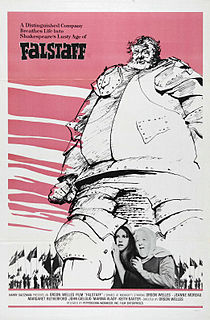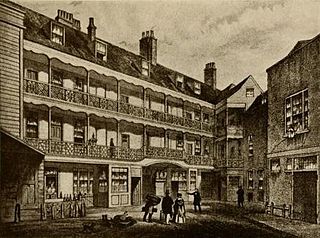
Sir John Falstaff is a fictional character who appears in three plays by William Shakespeare and is eulogised in a fourth. His significance as a fully developed character is primarily formed in the plays Henry IV, Part 1 and Part 2, where he is a companion to Prince Hal, the future King Henry V of England. Falstaff is featured as the buffoonish suitor of two married women in The Merry Wives of Windsor. Though primarily a comic figure, Falstaff embodies a depth common to Shakespeare's major characters. A fat, vain, and boastful knight, he spends most of his time drinking at the Boar's Head Inn with petty criminals, living on stolen or borrowed money. Falstaff leads the apparently wayward Prince Hal into trouble, and is ultimately repudiated after Hal becomes king.

The Merry Wives of Windsor or Sir John Falstaff and the Merry Wives of Windsor is a comedy by William Shakespeare first published in 1602, though believed to have been written in or before 1597. The Windsor of the play's title is a reference to the town of Windsor, also the location of Windsor Castle, in Berkshire, England. Though nominally set in the reign of Henry IV or early in the reign of Henry V, the play makes no pretence to exist outside contemporary Elizabethan-era English middle-class life. It features the character Sir John Falstaff, the fat knight who had previously been featured in Henry IV, Part 1 and Part 2. It has been adapted for the opera at least ten times. The play is one of Shakespeare's lesser-regarded works among literary critics. Tradition has it that The Merry Wives of Windsor was written at the request of Queen Elizabeth I. After watching Henry IV Part I, she asked Shakespeare to write a play showing Falstaff in love.

Henry IV, Part 1 is a history play by William Shakespeare, believed to have been written no later than 1597. The play dramatises part of the reign of King Henry IV of England, beginning with the battle at Homildon Hill late in 1402, and ending with King Henry's victory in the Battle of Shrewsbury in mid-1403. In parallel to the political conflict between King Henry and a rebellious faction of nobles, the play depicts the escapades of King Henry's son, Prince Hal, and his eventual return to court and favour.

Eastcheap is a street in central London that is a western continuation of Great Tower Street towards Monument junction. Its name derives from cheap, the Old English word for market, with the prefix 'East' distinguishing it from Westcheap, another former market street that today is called Cheapside.

Sir John Oldcastle is an Elizabethan play about John Oldcastle, a controversial 14th-/15th-century rebel and Lollard who was seen by some of Shakespeare's contemporaries as a proto-Protestant martyr.

Sir John Fastolf was a late medieval English landowner and knight who fought in the Hundred Years' War. He has enjoyed a more lasting reputation as the prototype, in some part, of Shakespeare's character Sir John Falstaff. Many historians argue, however, that he deserves to be famous in his own right, not only as a soldier, but as a patron of literature, a writer on strategy and perhaps as an early industrialist.

Ancient Pistol is a swaggering soldier who appears in three plays by William Shakespeare. Though full of grandiose boasts about his prowess, he is essentially a coward. The character is introduced in Henry IV, Part 2 and reappears in The Merry Wives of Windsor and Henry V.

Falstaff is a 1966 period comedy-drama film directed by and starring Orson Welles. The Spanish-Swiss co-production was released in the United States as Chimes at Midnight and in most of Europe as Falstaff. The film's plot centres on William Shakespeare's recurring character Sir John Falstaff and the father-son relationship he has with Prince Hal, who must choose between loyalty to his father, King Henry IV, or Falstaff.

Falstaff – Symphonic Study in C minor, Op. 68, is an orchestral work by the English composer Edward Elgar. Though not so designated by the composer, it is a symphonic poem in the tradition of Franz Liszt and Richard Strauss. It portrays Sir John Falstaff, the "fat knight" of William Shakespeare's Henry IV Parts 1 and 2.

Mistress Nell Quickly is a fictional character who appears in several plays by William Shakespeare. She is an inn-keeper, who runs the Boar's Head Tavern, at which Sir John Falstaff and his disreputable cronies congregate.

Robert Lewis Roumieu otherwise R.L. Roumieu, was a 19th-century English architect whose designs include Milner Square in Islington and an idiosyncratic vinegar warehouse at 33–35 Eastcheap in the City of London. A pupil of Benjamin Dean Wyatt, he worked in partnership with Alexander Dick Gough between 1836 and 1848.

In the historical era of English Renaissance drama, an Inn-yard theatre or Inn-theatre was a common inn with an inner courtyard with balconies that provided a venue for the presentation of stage plays.

Dorothy "Doll" Tearsheet is a fictional character who appears in Shakespeare's play Henry IV, Part 2. She is a prostitute who frequents the Boar's Head Inn in Eastcheap. Doll is close friends with Mistress Quickly, the proprietress of the tavern, who procures her services for Falstaff.

At the Boar's Head is an opera in one act by the English composer Gustav Holst, his op. 42. Holst himself described the work as "A Musical Interlude in One Act". The libretto, by the composer himself, is based on Shakespeare's Henry IV, Part 1 and Henry IV, Part 2.
The Boar's Head Theatre was an inn-yard theatre in the Whitechapel area of London from 1598 to around 1616.

Edward "Ned" Poins, generally referred to as "Poins", is a fictional character who appears in two plays by Shakespeare, Henry IV, Part 1 and Henry IV, Part 2. He is also mentioned in The Merry Wives of Windsor. Poins is Prince Hal's closest friend during his wild youth. He devises various schemes to ridicule Falstaff, his rival for Hal's affections.

The Boar's Head Inn was a tavern in Eastcheap in the City of London which is supposed to be the meeting place of Sir John Falstaff, Prince Hal and other characters in Shakespeare's Henry IV plays.

The Boar's Head Inn was an inn at Southwark in London, owned by Sir John Fastolf, who is the source for the character-name of Falstaff. While the Eastcheap Boar's Head Inn is not known to have existed during the reign of Henry IV, this inn may have.
Boar's Head may refer to:


















